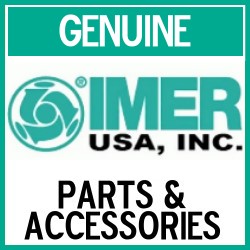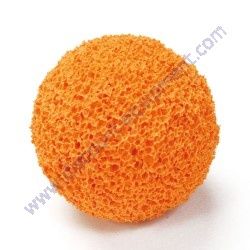IMER Mix 120 Plus (Mortarman) 1194302 4CF 2hp 110v Portable Specialty Mixer - Includes new iDust Grate
Safety Information
IMER MIX 120 Plus Portable Vertical Shaft Mixer
- WORKING IN SAFETY
To work in complete safety, read the following instructions carefully
before using the machine.
This OPERATION AND MAINTENANCE manual must be kept by the
Site Manager and be always available for consultation.
The manual is considered part of the machine and must be stored for
future reference (EN 12100-2) through to scrapping of the machine itself.
Should the manual be lost or damaged, a replacement copy can be
ordered from the manufacturer.
The manual contains important information regarding site preparation,
machine use, maintenance procedures, and requests for spare parts.
Nevertheless, the installer and the operator must both have adequate
experience and knowledge of the machine prior to use.
In order to ensure operator safety, safe operation and long service life,
it is imperative to adhere to the instructions set out herein and the requirements of the legislation in force governing safety in the workplace.
Use individual safety equipment (suitable shoes and clothing, gloves,
safety glasses, etc.).
- Make sure that all signs are legible.
- It is strictly forbidden to carry out any form of modification to the steel structure or working parts of the mixer.
IMER INTERNATIONAL accepts no liability for failure to comply with
laws governing the use of this type of equipment, with particular reference
to: improper use, incorrect power supply, lack of maintenance,
unauthorized modifications, failure to comply, either wholly or partially,
with the instructions set out in this manual.
IMER INTERNATIONAL reserves the right to modify features of the mixer
and contents of this manual, without the obligation to update previous
machines and/or manuals.
5. SAFETY MEASURES
The IMER mixer is designed to operate on construction sites and is not
equipped with its own lighting; the work site must be well illuminated
(min. 300 lux).
- Never use the machine in areas at risk of explosion/fires.
1. The IMER mixer will only run if all its safety devices are in place
and in perfect condition.
2. Do not use improvised and/or defective power supply lines.
3. The connection lines on the site must be laid in such a way that they cannot be damaged. Never stand the mixer on its power supply cable.
4. The plug/socket connections must be protected from water.
Use only connectors equipped with protection against water jets
(IP67).
5. Repairs to the electrical installation must be performed exclusively
by specialized personnel. Do not make any adjustments or
carry out any maintenance work while the machine is powered up
or running.
- Never put your hands or tools into the tank while the machine is running.
- Take care, when handling mix components, not to raise dust
which may be inhaled. If this is not possible, masks must be worn
to protect the mouth and nose.
- To stop the mixer, use the switch. Do not attempt to stop the mixer in any other manner.
6. ELECTRICAL SAFETY
The IMER mixer is constructed in line with the provisions of EN 60204-1,
and is protected against jets of water (IP 55) and equipped with protections
against overloads and automatic restarting after power failures.
7. MECHANICAL SAFETY
The hazardous points on the IMER mixer are protected by means of
safety devices, which must remain fitted at all times and kept in perfect
condition - as, for instance, the drive belt guard.
The tank is fitted with a guard which enables mix components to be loaded
into it while preventing access to the mixing area (ref.10, fig.1).
The machine is equipped with an electrical safety (interlock) which prevents
it from running when the mixer tank guard is open.
The machine is also equipped with a guard on its outlet to prevent access
to the mixing area.
8. TRANSPORT
Use the machine’s handles
to move it; these must be pulled out one at a time:
1. grasp a handle and remove its locking pin.
2. Pull the handle fully upwards.
3. Fit the locking pin.
Repeat with the other handle.
The mixer may also be moved with its four wheels.
- Before moving the mixer in this way, make sure the tank guard safety hook is engaged.
When lifting with a hoist or similar equipment, hook a four-point harness
into the holes on the frame. Make sure the harness has arms of at least 1500 mm.
- Each arm of the harness must be rated for loads greater than the total weight of the mixer.
- Always pull out its power plug before moving the mixer.
15. RESIDUAL RISKS AND SAFETY NOTICES
Although the machine is constructed in line with established legislation,
certain residual risks cannot be eliminated and require the use of individual
safety equipment. The machine is equipped with notices to indicate
the residual risks and how to avoid them.
NOISE HAZARD
Wear ear defenders
HAND CRUSHING/SHEARING HAZARD
Wear gloves
EYE INJURY HAZARD
Wear safety glasses
INCORRECT USE HAZARD
Read the manual before operating the machine
TRAPPING/CRUSHING AND SHEARING HAZARD
Do not remove the guards
Do not touch drive components
ELECTROCUTION HAZARD
Danger - electrical power
Note that the employer is responsible for ensuring his workers use individual
safety equipment.
SILICA DUST WARNING
Grinding/cutting/drilling of masonry, concrete, metal and other materials
with silica in their composition my give off dust or mists containing crystalline
silica. Silica is a basic component of sand, quartz, brick clay, granite
and numerous other minerals and rocks. Repeated and/or substantial
inhalation of airborne crystalline silica can cause serious or fatal respiratory
diseases, including silicosis. In addition, California and some other
authorities have listed respirable crystalline silica as a substance known
to cause cancer. When cutting such materials, always follow respiratory
precautions.
Use appropriate NIOSH-approved respiratory protection where dust
hazard may occur. Paper masks or surgical masks without a NIOSH
approval number are not recommended because they do little to protect
the worker. For more information about respirator programs, including
what respirators have received NIOSH approval as safe and effective,
please visit the NIOSH website at:
http://www.cdc.gov/niosh/topics/respirators
Observe OSHA regulations for respirator use (29 C:F.R. § 1910.134).
Visit http://www.osha.gov for more information.
California proposition 65 message
Some dust created by power sanding, sawing, grinding, drilling, and
other construction activities contain chemicals know (to the State of California)
to cause cancer, birth defects or other reproductive harm. Some
examples of these chemicals are:
-Lead, from lead-based paints
-Crystalline silica, from bricks and cement and other masonry products
-Arsenic and chromium, from chemically treated lumber
For further information , consult the following sources:
http://www.osha.gov/dsg/topics/silicacrystalline/index.html
http://www.cdc.gov/niosh/docs/96-112/
http://oehha.ca.gov/prop65/law/P65law72003.html
http://www.dir.ca.gov/Title8/sub4.html
http://www.P65warnings.ca.gov
Your risk from these exposures varies depending on how often you do
this type of work. To reduce your exposure to these chemicals, work in a
well-ventilated area, and work with approved safety equipment, such as
dust masks that are specially designed to filter out microscopic particles.
Where use of a dust extraction device is possible, it should be used. To
achieve a high level of dust collection, use an industrial HEPA vacuum
cleaner. Observe OSHA 29 CFR part 1926.57 and 1926.103. |













